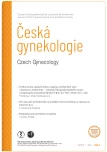Triple pregnancy – etiology and early diagnosis
Authors:
V. Osičková 1; Hynek Heřman 2; Radovan Pilka 3
Authors‘ workplace:
Gynekologicko-porodnické oddělení, Nemocnice Vyškov, p. o.
1; Ústav pro péči o matku a dítě, Praha
2; Porodnicko-gynekologická klinika LF UP a FN Olomouc
3
Published in:
Ceska Gynekol 2022; 87(5): 338-344
Category:
doi:
https://doi.org/10.48095/cccg2022338
Overview
Objective: To provide an overview of the etiology and early diagnosis of triple pregnancy, with emphasis on the possibilities of ultrasound and magnetic resonance (MR) imaging. Methodology: Processing of data from the available literature on the issue of triple pregnancy. Conclusion: Spontaneous triple pregnancy conception is rare. In most cases, it is a concept associated with assisted reproduction methods. Multiple pregnancy is associated with a higher incidence of complications during pregnancy and childbirth, but it also has its own specific complications. Chorionicity and amnionicity of multiple pregnancies are two important parameters in determining the strategy of dispensary care in pregnancy and management of childbirth. The use of ultrasound and MR imaging is crucial for their accurate determination in early pregnancy.
Keywords:
multiple pregnancy – triple pregnancy – high-risk pregnancy
Sources
1. Roztočil A. Porodnictví v kostce. Praha: Grada Publishing 2020.
2. Zákon pro lidi. Předpis č. 373/2011 Sb., Zákon o specifických zdravotních službách, Sbírka zákonů České republiky. Dostupné z: https: //www.zakonyprolidi.cz/cs/2011-373.
3. Svobodová M, Březinová J, Oborná I et al. Prevence vícečetného těhotenství po metodě IVF/ICSI elektivním transferem jednoho embrya – pilotní studie. Ceska Gynekol 2005; 70 (5): 343–347.
4. Sobek A, Procházka M, Klásková E et al. High incidence of monozygotic twinning in infertility treatment. Biomed Pap Med Fac Univ Palacky Olomouc Czech Repub 2016; 160 (3): 358–362. doi: 10.5507/bp.2016.016.
5. Český statistický úřad. Vývoj obyvatelstva České republiky – 2020, 4. Porodnost, str. 38–50. Dostupné z: https: //www.czso.cz/csu/czso/vyvoj-obyvatelstva-ceske-republiky-2020.
6. Steinman G. Mechanisms of twinning: X. The male factor. J Reprod Med 2008; 53 (9): 681–684.
7. Tagliani-Ribeiro A, Oliviera M, Sassi AK et al. Twin town in South Brazil: a Nazi’s experiment or a genetic founder effect? PLoS One 2011; 6 (6): e20328. doi: 10.1371/journal.pone.0020328.
8. Sadler WT. Langmanova lékařská embryologie. Praha: Grada Publishing 2010.
9. Adegbite AL, Ward SB, Bajoria R. Perinatal outcome of spontaneously conceived triplet pregnancies in relation to chorionicity. Am J Obstet Gynecol 2005; 193 (4): 1463–1471. doi: 10.1016/j.ajog.2005.02.098.
10. Smith N, Smith A. Ultrazvuk v porodnictví – praktická příručka. Praha: Grada Publishing 2006.
11. Mhatre M, Craigo S. Triplet pregnancy: what do we tell the prospective parents. Prenat Diagn 2021; 41 (12): 1593–1601. doi: 10.1002/pd.5852.
12. Saleem SN. Fetal MRI: an approach to practice: a review. J Adv Res 2014; 5 (5): 507–523. doi: 10.1016/j.jare.2013.06.001.
13. Shepherd LJ, Smith GN. Conjoined twins in a triplet pregnancy: a case report. Case Rep Obstet Gynecol 2011; 2011: 235873. doi: 10.1155/ 2011/235873.
14. Ozcan HC, Ugur MG, Mustafa A et al. Conjoined twins in a triplet pregnancy. A rare obstetrical dilemma. Saudi Med J 2017; 38 (3): 307–309. doi: 10.15537/smj.2017.3.16103.
15. Athanasiadis AP, Tzannatos C, Mikos T et al. A unique case of conjoined triplets. Am J Obstet Gynecol 2005; 192 (6): 2084–2087. doi: 10.1016/j.ajog.2004.10.622.
16. Ayhan A, Dursun P, Karakaya BK et al. Neoadjuvant chemotherapy followed by cesarean radical hysterectomy in a triplet pregnancy complicated by clear cell carcinoma of the cervix: a case presentation and literature review. Int J Gynecol Cancer 2012; 22 (7): 1198–1202. doi: 10.1097/IGC.0b013e31825e0d5a.
17. Bassil S, Gordts S, Nisolle M et al. A magnetic resonance imaging approach for the diagnosis of a triplet cornual pregnancy. Fertil Steril 1995; 64 (5): 1029–1031. doi: 10.1016/s0015-0282 (16) 57923-0.
18. Běhávková K, Krofta L, Macková K et al. Analýza případů monochoriálních dvojčat porozených v Ústavu pro péči o matku a dítě ve čtyřletém období (2012–2015). Ceska Gynekol 2017; 82 (3): 180–189.
19. Sobek A Jr, Procházka M, Klásková E et al. Trojčetní těhotenství se smíšenou chorionicitou po léčbě IVF: je fetoredukce vhodná? Ceska Gynekol 2017; 82 (2): 118–121.
20. Vlašínová I, Hruban L, Janků P et al. Specifické komplikace u monochoriálních biamiálních dvojčat porozených po 24. týdnu gravidity – retrospektivní analýza. Ceska Gynekol 2015; 80 (3): 189–195.
21. Kováčová H, Matura D, Šimetka O et al. Vzácné formy feto-fetální trasfuze v klinické praxi. Ceska Gynekol 2017; 82 (3): 190–196.
22. Yamashita S, Ikemoto Y, Ochiai A et al. Analysis of 122 triplet and one quadruplet pregnancies after single embryo transfer in Japan. Reprod Biomed Online 2020; 40 (3): 374–380. doi: 10.1016/j.rbmo.2019.11.008.
Labels
Paediatric gynaecology Gynaecology and obstetrics Reproduction medicineArticle was published in
Czech Gynaecology

2022 Issue 5
Most read in this issue
- Idiopathic granulomatous mastitis
- Distal vaginal agenesis and differential diagnosis of other causes of hematocolpos
- Effect of manual lymphatic drainage on upper limb lymphedema after surgery for breast cancer
- Psoriasis vulvae
